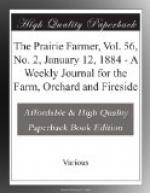As a rule these street and division trees are of a race wholly unknown in this country excepting a few trees of the Ostheim in Iowa and Minnesota. They are classed in the books as Griottes with colored juice and long, slender, drooping branches. The trees are smaller than our English Morello with low stems, and neat round tops. While some other races are hardy on this plain as far north as Warsaw in Poland and Russia the Griottes are grown for three main reasons. (1) The trees are deep rooted and so small in size that they do little shading of the street or cultivated fields. (2) They rarely fail to bear full crops as the fruit buds are hardier and the fruit buds expand later than the Kentish and the other and more upright forms of the Morello. (3) The fruit is less acid and richer in grape sugar than the Kentish forms making it more valuable for dessert, culinary use, and above all for making the celebrated “Kirsch wasser” which here takes the place of wine. Some of the thin twigged Griottes with dark skins and colored juice are as large in size as our Morello and nearly or quite as sweet. That they will prove hardy and fruitful with us we can hardly doubt as they grow on the dry plains of Northeast Europe where the Kentish forms utterly fail. Why have they not been introduced? I once asked this question of Mr. George Ellwanger, of Rochester, N.Y. He replied that in the early days of their nursery some varieties of the Weichel type were introduced in their collection. But the Eastern demand ran in the line of the Heart cherries and the Dukes, and if sour cherries were wanted for pies the Kentish forms with uncolored juice seemed to be preferred. I suspect the difficulty of propagation and the inferior look of the little thin twigged trees in the nursery had something to do with the ignorance of our people of the merits of this hardy and fruitful race. In the trying climate of the Swabian Alps, the Tyrol, and the east plain of Silesia, Hungary, Poland, and South Russia, the trees are on their own roots mainly, and the sprouts are used for propagation. When small they are placed in the nursery with the tops and roots cut back in the form of root-grafts. For the use of methodic growers and or planting on private grounds where sprouts are not wanted the trees are budded or inarched on Prunus Padus.
How will we propagate this valuable race of the cherry? The scions are too small for profitable grafting, and budding on our Morello seedlings hardly answers, as the slow-growing top favors sprouting from the root. Perhaps we shall find that our bird cherry (Prunus Pennsylvanica) is best suited for our use. The question of propagation of this race is important, as the cherries grown in immense quantities in the Province of Vladimir, one hundred and fifty miles east of Moscow, and in all the provinces of the upper Volga are of this thin twigged race. Beyond all doubt it is the coming cherry for universal use in Central and Northern Iowa, and even in Dakota and the far Northwest. Yet it is not the only race of the cherry which will thrive on our prairies and prove longer-lived, more fruitful, and far better in quality than any we now have.




